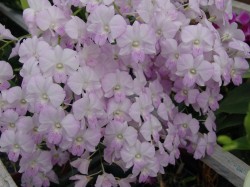Hawaii Orchids Today

Community Contributed
By Glenn I. Teves, UH County Extension Agent
Dendrobium orchids are a major export crop for Hawaii, and are broken into two segments, cut flowers and potted plants. Potted plant production is fairly new, and focuses on compact plants with short sprays facilitating ease of shipping.
The Hawaii dendrobium cut flower industry is based on one dendrobium cultivar, Dendrobium Jaquelyn Thomas, a primary cross of two species, Dendrobium phalaenopsis and Dendrobium gouldii. Together, the best qualities of both parents emerge in an intermediate-sized flower with a shelf life exceeding four to six weeks. This cultivar’s flower color can be found in white, pink, blush, two-tone, and purple.…













